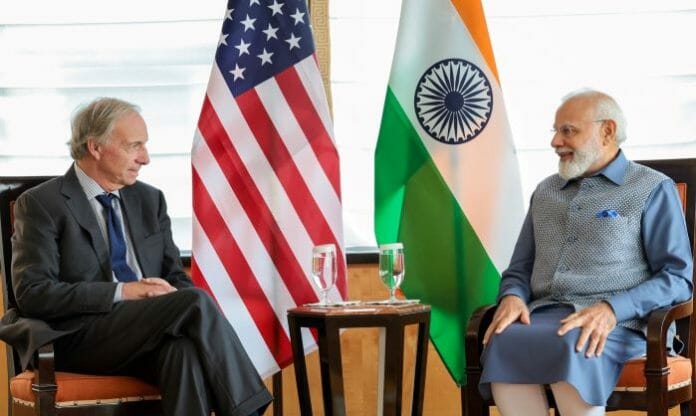Modi’s visit to the US creates a new undertone of practical trust and security interdependence in securing both countries’ immediate concerns on both Beijing and Moscow. Washington needs Delhi to lessen its defence dependence on Moscow, and by that, it will need to step up its military and defensive ties with Delhi that transcend beyond arms sales and joint military asset development alone. Being the oldest modern democracy and the largest democracy alone will not guarantee both countries’ unwavering ties, as shared systemic threats loom large as being the most critical linchpin that reorients Delhi-Washington relations that underscore regional and global stability.
China’s no-holds-barred playbook in the region and beyond has caused realignments of policies and approaches, creating a new power adjustment and manoeuvre that backfire on Beijing’s regional agenda.
While the US has been deemed to be late in the game of regaining regional dominance and reasserting regional pushback against China, the lack of matching power capacities and readiness to counterbalance Beijing’s growing muscle flexing and economic and military coercions have resulted in regional haplessness in jettisoning itself from Beijing’s orbit.
Structural and systemic economic dichotomy has rendered most regional players trapped in their policy affiliations and provided a better path for Beijing while limiting Washington’s overtures in courting a more integrated regional response.
In comes India. While Delhi has historically been a regional leader in the non-aligned model since the Cold War, contextual realities that entrap Delhi’s security outlook have created a new strategic clarity of India First Doctrine, in ensuring the immediate assurances of the collective security spectrum of the country.
India’s Indo-Pacific dreams have always been stymied by the shadow of Beijing’s economic and military might, which prevented a full regional onboarding capture of both the soft and hard power paradigm of Delhi. With Beijing’s weakening economic fundamentals and nearing its peak power prime, Delhi is looked at as the only worthy and well-deserved successor to cement its democratic and economic version that is vastly different from Beijing and more accommodating to both the East and West and the North and South.
While the major axis of powers including the US and China are caught in the mantra of great state autism, where an ingrained sense of power and influence affiliation hinders significant policy shifts and compromises, Delhi has better capacity and short-term advantages in moulding its leverage and bargaining chips.
The US sees Beijing as the ultimate most serious long-term challenge to the rules-based order and its own survival, and Delhi is desperately needed as the main anchor in checking Beijing both geographically and in a combined hard power deterrence.
In this calculation, Washington has limited options but to compartmentalise and structuralise the ties with Delhi, in avoiding putting further pressure on issues including human rights, ties with Moscow, and its apparent flip-flop on key issues and responses to both Moscow and Beijing.
Seen as the weakest link in Quad, India’s role has been argued to be softening Quad’s intent, thus making it vulnerable to being engulfed by Moscow in using security and energy chips as the chokepoints in curtailing its options in facing Beijing.
Beijing sees Delhi as not a lost cause, in trying to capitalise on its reliance on Moscow and its historical disdain for a bloc mentality to push the case for long-term commitment to the Asian-led structure of pushback against the Western order.
India’s peaceful rise has often been overlooked, but its future regional role in counterbalancing Beijing is insufficient without full head-on support from the US.
Delhi is well aware of its late entry into the Indo Pacific, and to counter Beijing’s entrenched presence in the region both in hard and soft power overtures will require a sustainable self progressive internal economic and military capacity and a robust network of trusted allies and partners.
Both factors remain elusive, and the US is the most critical factor in ensuring Delhi gets the two-pronged fronts in securing its own security and in ensuring its rise remains on track.
For this, Modi is realistic enough not to fully embrace Nehru’s stance on neutrality, and he sees the need for a more strategic and lasting model in keeping Beijing out, Washington in, Moscow in the balance, and Delhi on the course of regional stability.
While Delhi’s long term security assurances will need the inevitable systemic support from Washington, its short-term interests are slightly more susceptible to Moscow and Beijing’s tool of using Delhi as both the economic opening and geostrategic leverage in checkmating Washington’s grand options.
Delhi remains defiant of Washington’s displeasure in its continuous refrain from adhering to Washington’s want of displaying toughness on Putin and halting the oil purchase. It remains crucial for Delhi for its current economic and security dependence and for historical indebtedness to Moscow not to embrace the full-on bandwagon of Washington in chastising Moscow. Delhi is also wary of Washington’s courting of Islamabad in trying to deny Beijing’s presence there.
While Washington can remain tolerating for now, Delhi’s room to manoeuvre is running thin as it tries to squeeze every bit out of its unpredictability in its overtures. As Modi has made clear his thirst for Washington’s economic, technological and security assurances, he has also kept his chips and cards wide open.
Counter-measures to deal with the rise of India have been picking up steam. Other options to limit Delhi’s power capacity and rise include narratives and strategies that encourage New Delhi to maintain its historical uniqueness of foreign policy independence and strategic autonomy, thus reducing its options to fully affiliate and integrate into the Western core-periphery.
Through this, the hope is on how the containment capacity of China will be further weakened, and that a direct challenge to its primacy will be further fragmented.
Well aware of Beijing’s encirclement through the strings of pearls theory, the increased presence in arch nemesis Pakistan and increasingly in Bangladesh and Sri Lanka will need urgent and strategic counterbalance responses by Delhi. Its capacity was stretched, and Beijing’s expansionism forced Delhi to increase its military matching speed.
The Himalayan border confrontation is geostrategically critical not only to Delhi but to the West in using that as a crucial second front in stymieing Beijing’s reach and in distracting its capacity in the Indo Pacific, especially in the South China Sea and Taiwan.This creates a win-win situation for both Delhi and Washington. The former will need the latter’s extended deterrence support in securing this front, especially in denying re-engaging crucial neighbouring players including Pakistan and Afghanistan to break Beijing’s links and leverage on these players in the event of a potential all-out conflict over the border.
Washington will need Delhi to maintain a high-intensity readiness and uncompromising stance on the border sovereignty which will divide Beijing’s attention and resources.
With the loss of Afghanistan as a strategic geographical asset in counterbalancing China’s Central Asia manouvres, India remains the most crucial US partner in encircling China from its most vulnerable front, its Western flank.
The control over the First and Second Island Chains will be equally important as to the control of the Nicobar Island Chains, and this gives Delhi the ultimate card.
While Beijing is increasing its Indian Ocean presence to break Delhi’s backyard advantage, including intensified presence in Sri Lanka and in the Gwaddar port in Pakistan, Delhi remains behind in the naval race and submarine capacity.
The US is indispensable for Delhi in keeping Beijing out of the Indian Ocean, and the strategic base in Perth for the AUKUS submarines remains significant for both Delhi and Washington in pushing for extended deterrence and integrated maritime security and awareness for the South China Sea, the Indian Ocean and the critical Malacca, Sunda, and Lombok Straits. The latter two remain the passageways for Beijing’s submarines to the Indian Ocean, and the US remains the main player that is capable in supporting India in extending the naval presence and potential blockade in times of conflict in thwarting Beijing’s options in the Indian Ocean.
The same supportive tool is mutually needed by both Delhi and Washington in the tip of the entrance to the Straits of Malacca, with Indian control over Nicobar Island chain being crucial for the US in using that to cement its control over the strategic waterways in choking Beijing on food and energy supplies.
Delhi’s own “necklace of diamonds” to foil China’s “strings of pearl strategy” will need the US to complete the puzzle, and in developing a multi-pronged counter-offensive military readiness and resilience.
Its “Act East Policy” provides the opening to integrate India’s economy with Southeast Asian nations and strengthen military ties with them.
India and the US are not divided ideologically but national interests and immediate survival needs are paramount, which have necessitated India’s non-abidance to Washington’s full spectrum of expectations. Friendshoring to maximise capacity in facing Beijing and for potential de-risking and de-coupling will need Delhi’s unrelenting support as a trusted partner. Delhi will not be able to break Beijing’s regional hegemonic status alone, not with its own internal capabilities. While not breaking from its famous non-aligned model, India is not able to play to the same approach by regional players in hopes to get the best out of both worlds, as the outcome is worse off for Delhi.
It will need the US to secure its long-term security architecture, and that will need a more credible offer in soliciting Washington’s overtures. The US can face off Beijing in relatively successful terms without a full onboard of India, but can India survive without the US?
COLLINS CHONG YEW KEAT Foreign Affairs and Security Strategist UNIVERSITI MALAYA









